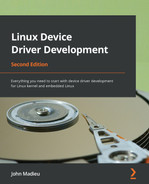Get up to speed with the most important concepts in driver development and focus on common embedded system requirements such as memory management, interrupt management, and locking mechanisms Linux is by far the most-used kernel on embedded systems. Thanks to its subsystems, the Linux kernel supports almost all of the application fields in the industrial world. This updated second edition of Linux Device Driver Development is a comprehensive introduction to the Linux kernel world and the different subsystems that it is made of, and will be useful for embedded developers from any discipline. You'll learn how to configure, tailor, and build the Linux kernel. Filled with real-world examples, the book covers each of the most-used subsystems in the embedded domains such as GPIO, direct memory access, interrupt management, and I2C/SPI device drivers. This book will show you how Linux abstracts each device from a hardware point of view and how a device is bound to its driver(s). You'll also see how interrupts are propagated in the system as the book covers the interrupt processing mechanisms in-depth and describes every kernel structure and API involved. This new edition also addresses how not to write device drivers using user space libraries for GPIO clients, I2C, and SPI drivers. By the end of this Linux book, you'll be able to write device drivers for most of the embedded devices out there. This Linux OS book is for embedded system and embedded Linux enthusiasts/developers who want to get started with Linux kernel development and leverage its subsystems. Electronic hackers and hobbyists interested in Linux kernel development as well as anyone looking to interact with the platform using GPIO, IIO, and input subsystems will also find this book useful.Key Features
Book Description
What you will learn
Who this book is for
Table of Contents
- Linux Device Driver Development Second Edition
- Contributors
- About the author
- About the reviewer
- Preface
- Section 1 -Linux Kernel Development Basics
- Chapter 1: Introduction to Kernel Development
- Chapter 2: Understanding Linux Kernel Module Basic Concepts
- Chapter 3: Dealing with Kernel Core Helpers
- Chapter 4: Writing Character Device Drivers
- Section 2 - Linux Kernel Platform Abstraction and Device Drivers
- Chapter 5: Understanding and Leveraging the Device Tree
- Chapter 6: Introduction to Devices, Drivers, and Platform Abstraction
- Chapter 7: Understanding the Concept of Platform Devices and Drivers
- Chapter 8: Writing I2C Device Drivers
- Chapter 9: Writing SPI Device Drivers
- Section 3 - Making the Most out of Your Hardware
- Chapter 10: Understanding the Linux Kernel Memory Allocation
- Chapter 11: Implementing Direct Memory Access (DMA) Support
- Chapter 12: Abstracting Memory Access – Introduction to the Regmap API: a Register Map Abstraction
- Chapter 13: Demystifying the Kernel IRQ Framework
- Chapter 14: Introduction to the Linux Device Model
- Section 4 - Misc Kernel Subsystems for the Embedded World
- Chapter 15: Digging into the IIO Framework
- Chapter 16: Getting the Most Out of the Pin Controller and GPIO Subsystems
- Chapter 17: Leveraging the Linux Kernel Input Subsystem
- Other Books You May Enjoy
